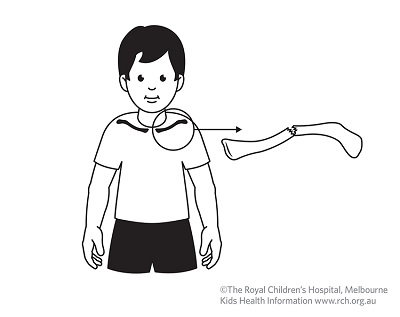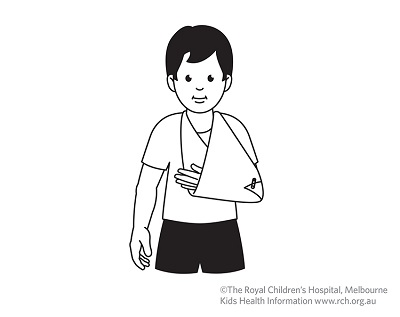If your child has a fractured clavicle (collar bone), they will usually heal well with rest and time. A cast is not needed. Clavicle fractures usually occur in the middle of the bone.

Most clavicle fractures have no displacement or only mild displacement, which means there is still some contact between the two ends of the bone at the site of the break.
This fact sheet provides information on what to do once your child has been treated in hospital for a clavicle fracture. If you think your child has a fracture and you are looking for first aid advice, see our fact sheet Fractures (broken bones).
Care at home
Your child should wear a sling for the first two to three weeks, including while they are in bed. This will help them feel more comfortable and help the fracture heal. Your child’s fingers should be higher than their elbow. Encourage your child to keep moving their hands and fingers while they
are wearing their sling.

During the first few days it is important for your child to rest as much as possible.
Fractures are painful. Although immobilising the arm with the sling will help to reduce the pain, additional pain relief (e.g. paracetamol) is often needed. Give the medication regularly for the first few days, following the directions on the packet, or as directed by the doctor.
Giving pain medications before bedtime will help your child have a better sleep, as lying down with a clavicle fracture will cause pain.
Your child can stop wearing the sling when the fracture site is no longer tender and your child can move the arm fully with little or no discomfort. In children, this is usually after three weeks, but can take as long as six weeks.
Follow-up
Children aged under 11 with an undisplaced fracture (ie there is some contact between the two broken ends of the bone) go on to heal very well, and do not need to have a follow-up appointment. Any angle formed by the two ends of the bone will remodel with time as it grows.
Children aged over 11 or in whom there is no contact between the two fractured ends of the bone should be reviewed by their GP or local hospital approximately two weeks after the injury to check healing.
A few children aged 14 or over may be referred directly to the Orthopaedic Department if there is no contact between the two ends.
After the sling is removed
Gentle shoulder movement can begin when the sling is removed. Your child may return to sports such as swimming as soon as it is comfortable to do so and pain-free. However, contact sports should be avoided for six weeks after the sling comes off, as they are at greater risk of it breaking again.
A lump at the fracture site is quite normal and may take about a year to disappear. In older children, a small bump may remain. This is no cause for concern.
Take your child to your GP if you are concerned about:
• pain at the site of the fracture which is not improving by three weeks
• persistent tingling or altered sensation in the arm or hand.
• shoulder or elbow stiffness that does not resolve
Key points to remember
- A fractured clavicle (collar bone) will usually heal well with rest and time.
- Your child should wear a sling until there is no tenderness over the fracture and they can move their shoulder without pain or discomfort (usually two to three weeks).
- Children older than 11 years or those who have a displaced fracture will need a follow-up appointment one to two weeks after their injury.
- Avoid contact sports for six weeks after removal of the sling.
For more information
Common questions our doctors are asked
Why doesn’t my child need a follow-up appointment?
We recommend that children aged over 11 have follow up at one to two weeks to check that healing is occurring normally. This is because some children in this age develop a condition where healing does not occur properly, particularly where the two ends of the bone do not come into any contact with one another. Some children over 14 may be referred directly to the Orthopaedic Department by the treating health professional.
Why do child children over 11 need a follow-up appointment?
If your child is older than 11 years, they should see their
GP for a follow-up appointment. This is because the majority of clavicle
fractures in this age group are displaced.
If my child has a lump at the fracture site that doesn’t go
away, can anything be done about this?
Usually
these lumps will eventually go away in a few years. If the lump does not get
smaller after this time, you can have it reviewed. See your GP for a referral.
Surgery may be an option, but most people do not elect to have the surgery
because the lump will not cause problems. Also, surgery will leave a scar that
is often more noticeable than the original lump.
Developed by The Royal Children's Hospital and the Victorian Paediatric Orthopaedic Network. We acknowledge the input of RCH consumers and carers.
Reviewed May 2021
Kids Health Info is supported by The Royal Children’s Hospital Foundation. To donate, visit
www.rchfoundation.org.au.